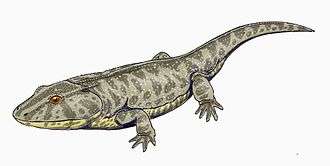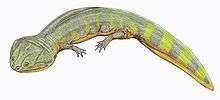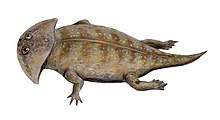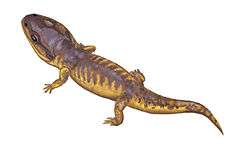Trematosauria
Trematosauria is one of two major groups of temnospondyl amphibians that survived the Permian-Triassic extinction event, the other (according to Yates and Warren 2000) being the Capitosauria. The trematosaurs were a diverse and important group that included many medium-sized to large forms that were semi-aquatic to totally aquatic. The group included long-snouted forms such as the trematosauroids and short, broad-headed forms such as the metoposaurs.[1] Although most groups did not survive beyond the Triassic, one lineage, the brachyopoids, continued until the Cretaceous period. Trematosauria is defined as all stereospondyls more closely related to Trematosaurus than to Parotosuchus, a capitosaurian.[2]
| Trematosauria | |
|---|---|
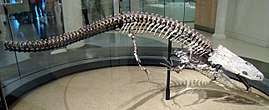 | |
| Skeleton of Koskinonodon perfecta in the American Museum of Natural History | |
| Scientific classification | |
| Kingdom: | Animalia |
| Phylum: | Chordata |
| Order: | †Temnospondyli |
| Suborder: | †Stereospondyli |
| Clade: | †Trematosauria Romer, 1947 |
| Clades | |
Classification
gollark: Any drive capable of bringing you up to ridiculous fractions of lightspeed will have a horribly dangerous exhaust, the power sources necessary could also run tons of weapons, and you can use said drive things to, I don't know, accelerate asteroids to high velocities and crash them into planets.
gollark: Ah, but their ships themselves would have to be weapons to travel interstellarly.
gollark: Technologically speaking.
gollark: What? Basically everything can be reapplied as weaponry somehow.
gollark: Any aliens capable of crossing interstellar distances to get to Earth can almost certainly deal with the asteroid thing.
References
- Brusatte, S. L., Butler R. J., Mateus O., & Steyer S. J. (2015). A new species of Metoposaurus from the Late Triassic of Portugal and comments on the systematics and biogeography of metoposaurid temnospondyls. Journal of Vertebrate Paleontology. e912988., 2015:
- Yates, A.M.; Warren, A.A. (2000). "The phylogeny of the 'higher' temnospondyls (Vertebrata: Choanata) and its implications for the monophyly and origins of the Stereospondyli" (PDF). Zoological Journal of the Linnean Society. 128 (1): 77–121. doi:10.1111/j.1096-3642.2000.tb00650.x.
- Sues, H.-D.; Fraser, N.C. (2010). Triassic Life on Land: The Great Transition. New York: Columbia University Press. p. 236. ISBN 0-231-13522-X.
External links
This article is issued from Wikipedia. The text is licensed under Creative Commons - Attribution - Sharealike. Additional terms may apply for the media files.
